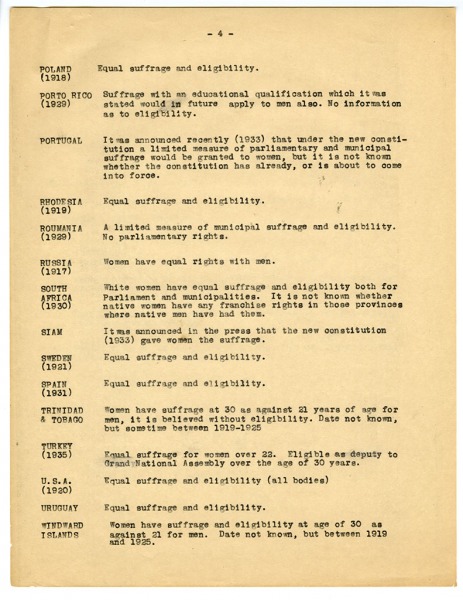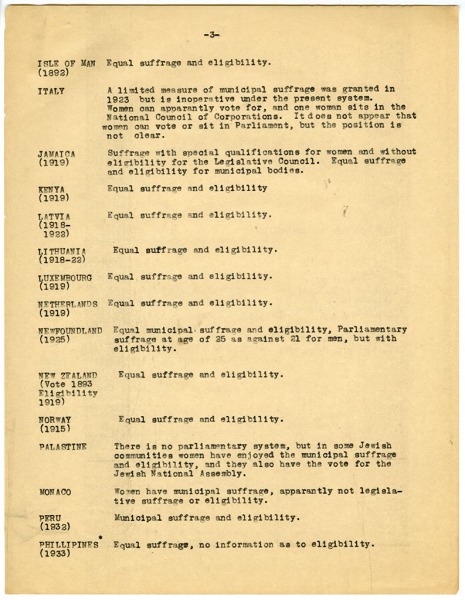The global women’s rights movement built momentum for equality in voting rights throughout the latter half of the 1800s. Nonetheless, according to Ramirez et al., less than one percent of all countries allowed women to vote as of 1900 (all men could vote in about 18 percent of countries at the time). Ultimately, the movement’s success culminated in women gaining the right to vote in national elections in most of Europe as well as in the European-settler countries of North America (Canada and the United States) and the South Pacific (Australia and New Zealand) during the first two decades of the 20th century (actually in 1893 in New Zealand). Arkansas, and the United States more broadly, were part of this trend. Nonetheless, there are some surprises among European countries. Women in France, for example, did not gain the right to vote until the 1940s. The last canton (state) in Switzerland to allow women to vote did so only in 1971.
In general, although there was transnational collaboration in the 1800s and early 1900s, women’s suffrage initially expanded largely in response to long national struggles and local mobilization. Many activists’ work has been lost to history. However, it is the case that, particularly in federal systems like the United States, women often gained the right to vote in state and local elections far ahead of gaining the right for national elections. In European-settler countries, women often were successful in frontier areas first, where gendered social, political, and economic norms often differed substantially from areas settled much earlier.
Australian women were some of the earliest to gain the right to vote. Women in the Australian state of Victoria gained the right to vote in 1863, though, according to the Australian government’s official history of the period, it was by accident. The legislation used the term “all persons” to refer to individuals on existing voter rolls. Voting rights were based on property ownership, but many women were property owners. The law was amended two years later to explicitly exclude women. Australian states began to grant women the right to vote in the 1890s; federally, the suffrage was extended in 1902.
Women's suffrage progressed differently in much of the rest of the world. While local activists still were instrumental in gaining the right to vote throughout the developing world, the transnational dimension was also important. Indigenous people in the non-European world, regardless of gender, enjoyed few political rights under European colonialism. By the 1950s and 1960s as decolonization was occurring across the developing world, women (and men) often gained the right to vote at independence. With women’s suffrage then the norm in existing states, there was normative expectation for new states to adopt similar practices. According to Ramirez et al., of the countries that became independent in the 20th century, only Austria, Ireland, and Libya granted men the right to vote before women. In the countries in which the franchise was not extended to women (or to anyone in some cases), transnational human rights activists and, less consistently, democratic countries put pressure on governments to extend voting rights. International conventions created in the post-World War II era professed a growing global consensus on gender equality, at least in the abstract. By 1980, the only holdouts on women’s suffrage were monarchies in the Persian Gulf that had not extended voting rights to any of their citizens. Today, women’s legal right to vote is virtually universal.
In the 21st century, much focus globally with respect to women’s civil and political rights has shifted to increasing women’s participation in politics and representation in government. Readers should keep in mind, though, that this discussion of the successful expansion of women’s suffrage has focused on formal legal voting rights. The struggle for securing these rights has not ended. In many countries today, women (and men) continue to be disenfranchised in practice, particularly if they are from racial, ethnic, and religious minorities.
Australian Government, “Australian Suffragettes.” (Accessed November 10, 2016).
Inter-Parliamentary Union, “Women’s Suffrage: A World Chronology of the Recognition of Women's Rights to Vote and to Stand for Election.” (Accessed November 10, 2016).
Ramirez, Francisco O., Yasemin Soysal, and Suzanne Shanahan, "The changing logic of political citizenship: Cross-national acquisition of women's suffrage rights, 1890 to 1990," American Sociological Review (1997): 735-745.
United Nations Entity for Gender Equality and the Empowerment of Women [UN Women], “In Pursuit of Justice” (United Nations, 2011). (Accessed November 10, 2016).
Eric Wiebelhaus-Brahm, Ph.D., is an assistant professor in the School of Public Affairs at the University of Arkansas at Little Rock. His research interests include human rights, conflict and post-conflict reconstruction, and democratization. In particular, he is interested in how societies address histories of violence and repression. Eric is the author of "Truth Commissions and Transitional Societies" (Routledge, 2010), as well as several articles that have appeared in journals such as the International Journal of Transitional Justice, Journal of Human Rights, and International Studies Perspectives. Before joining UA Little Rock in 2013, he taught at Florida State University and University of Nevada, Las Vegas.


